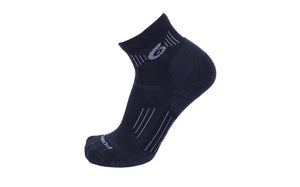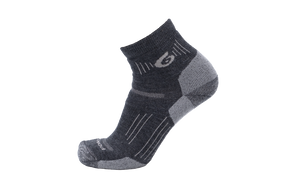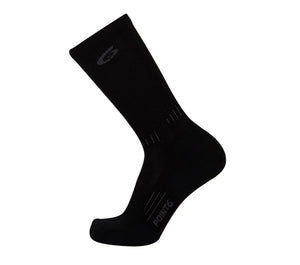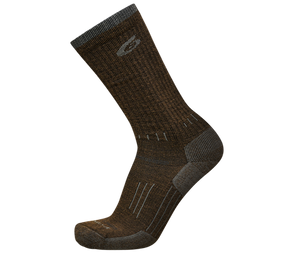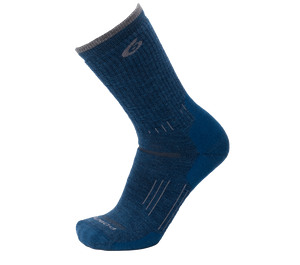
Merino wool originated in Spain in the early twelfth century from the Merino sheep. Within a century, it was renowned for its high-end quality and feel - everyone wanted to have it. In the 1700s, Spain began exporting sheep so other countries could produce merino wool. Today, New Zealand is the largest producer of merino wool.
So what makes merino wool so great anyways? Merino is excellent for layering and protects against a variety of elements. If you want to learn more about what makes merino wool so great, you've come to the right place. In this article, we'll discuss wearing merino wool vs wool and why you should use merino in your layering.
What Is Wool?
Wool is a natural fiber derived from sheep, goats, alpacas, and sometimes other animals. Wool fibers have a tubular shape that retains elasticity and naturally protects against the elements.
What Is Merino Wool?
Merino wool is a form of wool derived only from Merino sheep. It has the same structure as standard wood fibers and provides the same protection though its fibers are much finer .
Merino Wool Vs Wool Benefits
While both wool and merino wool have similar ways of protecting against the elements, they also have some key differences. There are some benefits to using merino wool over wool if you are considering layering up with the material.
Softness
The finer fibers in merino wool make it softer compared to standard wool. Since the strands are thin, they're not strong enough to stand up on their own. This prevents the wearer from feeling the prickly feeling we often describe as itchy with regular wool.
Regular wool may come from animals other than sheep, so the softness level varies depending on the source. Even sheep from different areas can have much different wool than others, ranging from coarse to soft.Lightweight
The thinner strands don't just make merino softer than other wools, they also make the material more lightweight and breathable. This feature makes merino wool one of the best materials for base layers. It can be worn underneath outerwear without feeling too heavy.
Protection From the Cold
Both merino wool and regular wool provide excellent protection from the cold. Wool fibers have a scale-like structure that creates larger air pockets and retains more warmth than other fibers. This allows it to trap body heat and keeps you well-insulated from the cold.
Durability
Because merino wool has thinner strands and is commonly used for lightweight base layers , it's not always as durable as your standard wool. Lightweight items are prone to wear , but heavyweight items last several years and stand up to the strength of Other fibers
Wool socks are often known to last a lifetime. Our merino wool socks are compact spun and thus25% more durable than ring-spun yarn and stand out against the competition.
High-Quality Natural Material
While natural products aren't always known for being the most comfortable, merino wool is one of the better-performing natural materials. It is softer than its wool counterpart and comes in a greater variety of options, unlike other natural products.
Fire Resistant
Merino wool doesn't melt or ignite in hot temperatures. It offers greater protection from high temperatures and fires than other materials like polyester. Merino's fire-resistant nature makes it one of the best options when considering protective layers for firefighter uniforms.
Regulates Body Temperature
Many of us don't think of wearing wool in the summer, but both standard and merino wool does a great job of regulating your body temperature in warm and cold climates.
When it's cold outside, the fibers will trap in body heat to keep you warm. In warm weather, it helps the moisture from your body evaporate to keep you cool.Merino does a slightly better job of regulating body temperature because it's more hydrophilic, meaning it can absorb a large percentage of its moisture. This keeps the fabric from sticking to your skin and gives your body room to breathe, helping it maintain the correct temperature.Water Resistant and Quick Drying
Both standard and merino wool are water resistant but are not waterproof. They are both absorbent, keep moisture off your skin, and dry quickly. Merino has a small advantage in drying due to the fine fibers that dry more quickly than the standard fibers in wool.
Better for Movement
Merino wool is lighter weight and easier to manipulate into clothing designed for movement. While it may not be as versatile as natural materials like cotton or synthetic polyester, the fibers in merino are flexible and adapt easily to movement.
Odor Resistant
If you're interested in wearing protective wool layers, it's likely that you will spend a lot of time in cool, harsh climates. When wearing base layers in the cold, you're more prone to sweat underneath all the layers.
Both types of wool have antimicrobial properties due to the natural lanolin from the sheep. Lanolin helps repel odor-causing bacteria. Since wool doesn't trap moisture, it discourages bacteria from growing.Discouraging bacteria growth prevents you and your clothes from smelling during work, hikes, or other activities in the cold. Preventing the growth of odor-causing bacteria also increases the longevity of your clothing.UPF Protection
No matter the type of weather, you should be taking steps to protect your skin from the sun's UV rays. While the sun's rays are the strongest in the summer months during the afternoon, they can do harm at any time. Clothing that boasts UPF protection blocks a percentage of the rays and reduces exposure.
Wool has natural UPF protection of 30 or higher while merino wool protects up to UPF 50. With this level of protection, wool keeps you safe from up to 98% of UV rays.Can Be Washed
While both types of wool can last longer without washing due to their antimicrobial properties, they still need to be cleaned from time to time. Wool, however, can't be washed the same way as other materials.
You can wash most modern wool varieties at home at a lower temperature, but you must be mindful of putting them in the dryer. It is only safe to put wool items in the dryer if they are pre-shrunk.Environment-Friendly
Wool is a renewable resource that is replenishable to continue replacing the materials used. A single sheep produces around 40 pounds of wool annually and continues to do so during its lifespan .
Wool is also naturally biodegradable, which means that it will break down quickly into the earth without releasing plastic microfibers into the environment like its synthetic counterparts. Fast fashion is one of the most damaging industries to our environment and prioritizing biodegradable materials makes a big difference.
Clothing made with wool also tends to be longer lasting, because it's less prone to getting dirty and sweaty. By going through fewer wash cycles, these pieces will be able to live in your closet longer and help slow down the consumption of fashion items.
Stylish Options
Wool has a bad reputation for having limited style options, such as wool outerwear or sweaters. Both types of wool have evolved for use in a variety of clothing options. The material's ability to drape, shape, and hold onto rich colors makes it an excellent one to work with.
Merino wool is a staple for basic layering items such as socks, baselayers, underwear, and leggings. However, you can also find wool in more fashionable items such as our joggers and hoodies
Wrinkle-Resistant
Merino wool is wrinkle-resistant due to the fibers' natural crimp. It is rare for any wrinkles to occur in wool, which makes it great for folding and packing for long trips. It requires less washing and will stay wrinkle-free so a few items of merino wool will go a long way on your travels.
How to Layer With Merino Wool

When wearing merino wool to protect yourself from the elements, knowing how to layer it will give you the best results. The number of layers you need depends on the thickness of the materials and the activity you plan on doing.
1. Start With a Base Layer
Wearing a merino base layer over your underwear is the best way to keep warm while minimizing moisture. In warm climates, this helps evaporate away sweat and keep your body cool. Base layers include different levels of tops and leggings, depending on the level of protection you need.
2. Cover With Mid-Layers
When layering for cold climates, you’ll want a mid-layer for added protection and warmth. Mid-layers might consist of a fleece, softshell, hoodie, or sweater. Choosing a merino wool mid-layer keeps things breathable while providing the warmth you need.
If you’re layering up in a warmer climate, you might want to wear a lightweight mid-layer as your outerwear to help keep you warm when it’s chilly without getting too hot.3. Put on Outerwear
Your outerwear protects you from the initial elements, but your base and mid layers do the heavy lifting to keep your body warm and dry. When layering, the type of outerwear that is most beneficial to you will depend on the activity. For hiking in wet climates, you’ll want something water-resistant or waterproof. Merino is water-resistant and comes in coats, puff jackets, and other outerwear. You may also consider a hardshell.
4. Don't Forget the Accessories
Merino wool socks are one of the best accessories for the outdoors. They keep your feet dry, odor-free, and comfortable. In cold weather, finish off your layering with some merino gloves and a hat.
Who Can Benefit From Layering With Merino Wool?
Merino wool is a great choice for adventurers, athletes, hikers, first responders, kids playing in the snow, and people living in harsh climates. These people are often outside in the elements for longer than usual, and staying warm and protected from the elements is important for both their safety and comfort.
Those with an active lifestyle can even benefit from merino wool in warmer climates because it is considered a natural performance fabric. It’s breathable and moisture-wicking during physical activity.Best Climates for Merino Wool
One of the best things about merino wool is that it excels in any climate. While often touted for its ability to keep you warm in the cold, it works just as well at keeping you cool in hot temperatures. Investing in merino wool clothing is a smart choice because it can be worn year-round and is ideal for those who travel often and need something that works well in a variety of climates.
Caring for Wool
The best method to follow when caring for your merino wool clothing is to follow the guidelines listed in the care instructions. Merino wool does not need washing as often as other clothing and the recommended time frame for washing is after every 3-20 wears. The less you wash, the longer it will last.
Wash your wool in cold water on a gentle cycle. Unless it’s pre-shrunk, avoid putting wool items in the dryer. Heat causes merino wool to lose its flexibility and shape, resulting in shrinkage. Hang-drying or towel-drying often works best.When It Comes to Merino Wool Vs Wool Layering, Marino Has The Edge
While both types of wool have several similarities, when comparing merino wool vs wool, merino takes an edge. Its lightweight nature makes it more breathable, soft, and versatile than standard wool.
At Point6, we believe that you should be able to get outdoors feeling comfortable and protected, no matter the climate. We’ve mastered the use of merino wool in our clothing to make it all possible. We offer a wide selection of merino wool clothing and socks to help you layer up in the cold. Shop our apparel collection today.

